This was published 1 year ago
Top Australian Open finals: Bitter disappointment for home hero Cash
IT is 35 years since Mats Wilander dashed the dreams of local hope Pat Cash in an epic final to close the first Australian Open played on the hard courts of Melbourne Park.
From 1988 onwards, Rod Laver Arena, the first grand slam stadium court to have a roof, has hosted some of the greatest major finals ever played.
Much has changed since, not least the colour scheme of the courts, with the green Rebound Ace replaced in 2008 by the current ocean blue acrylic surface.
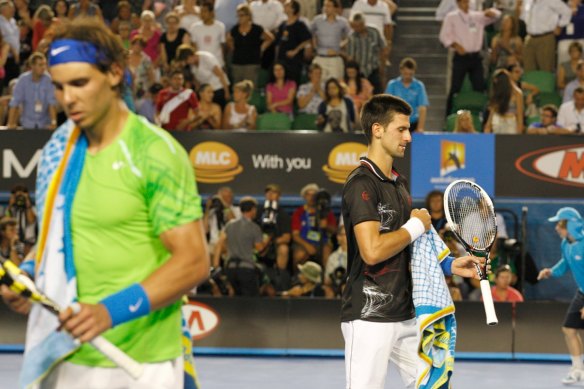
Rafael Nadal and Novak Djokovic: The two legends went toe-to-toe. Credit: Viki Lascaris
All the legends have produced magnificent moments: Roger Federer, Serena Williams, Novak Djokovic, Steffi Graf, Rafael Nadal, Monica Seles, Andre Agassi and Ash Barty are among the champions to hold aloft the championship trophies.
The Age and Sydney Morning Herald have selected some of the greatest deciders played at Rod Laver Arena based on their quality, the calibre of the finalists and the significance of the result.
We talked to some participants, either the players themselves or those in other roles at the time, for further insight.
In this instalment, we go back to 1988, when Pat Cash came within points of becoming the first Australian man since 1976 to claim his home title.
1988 Mats Wilander (SWE) d. Pat Cash (AUS) 6-3, 6-7 (3), 3-6, 6-1, 8-6
Pat Cash was in the midst of a sweaty practice session on a court at his parents’ place in North Ringwood ahead of the historic 1988 Australian Open when his dad yelled out to him.
“Mats is on the phone. He wants to come and have a hit on the court,” Pat Cash snr told his son.
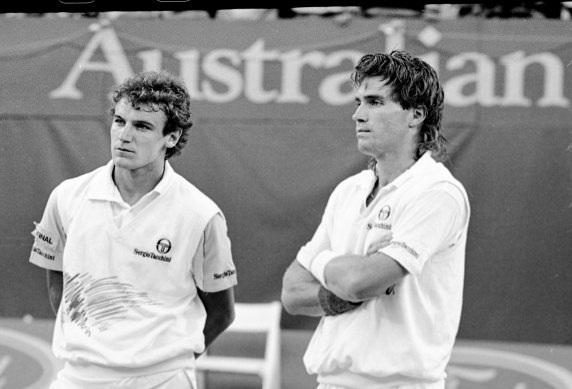
Wilander and Cash trained together and celebrated togetherCredit: The Age
The 1987 Wimbledon champion said he told his dad, “Yeah. No worries”. To which his father, Pat Cash snr, replied; “Are you sure? You should have a good think about this.”
With the first Australian Open to be played at what was then known as Flinders Park just days away, Cash’s dad was wary of giving a title rival additional time to adjust to the surface.
But Cash was aware that, given their lofty seedings, he could only meet the Swedish star in the final and felt that doing a good mate a small favour would not matter in the end.
“Mats and I had gone back a long, long way. He was the first international kid that I hit with when I was in Europe when I was 13 and we have always been mates,” he said.
“I told dad, ‘If I happen to meet him then, it is only going to come down to a couple of points. It’s going to have nothing to do with practice three weeks before the final’.”
In the best form of his life, the Australian reached the final of his home grand slam for the second straight year. And it did come down to the last couple of points.
In establishing itself as the new home of Australia’s grand slam, Flinders Park could not have received a better housewarming gift than the finals weekend.
Steffi Graf defeated American legend Chris Evert to claim the first leg of what became a Golden Grand Slam in 1988. Then the local hero took to the court against a popular Swede.
Wilander, who won seven major titles, settled better in windy conditions before Cash responded after a rain break in the second set to seize the momentum.
Another rain break swung the momentum back to Wilander, but the Melburnian was able to come from a break down in the fifth set to push the decider to an advantage ending.

Cash came closer than any Australian man since 1976 to winning the Open title.Credit: The Age
Cash was within points of becoming the first Australian man since Mark Edmondson in 1976 to claim his own Open. No Australian man has come closer since.
“At the end it boiled down to a few great shots from Mats, a few points here and there,” Cash said.
“I really think that I played a good match. But Mats was just a little bit better at the end.”
Having welcomed Wilander into his home, Cash ended up commiserating with the Swede as he was celebrating the first of three grand slam titles for the year.
“We all headed down to the old Metro. I went in to have a couple of quiet beers with my team and Mats was there celebrating,” he said.
“I can’t tell you how bitterly disappointed I really was. But he was a mate and I congratulated him.”
1993 Monica Seles (USA) (Fed Rep of Yugoslavia at the time) d. Steffi Graf (GER)
4-6, 6-3, 6-2
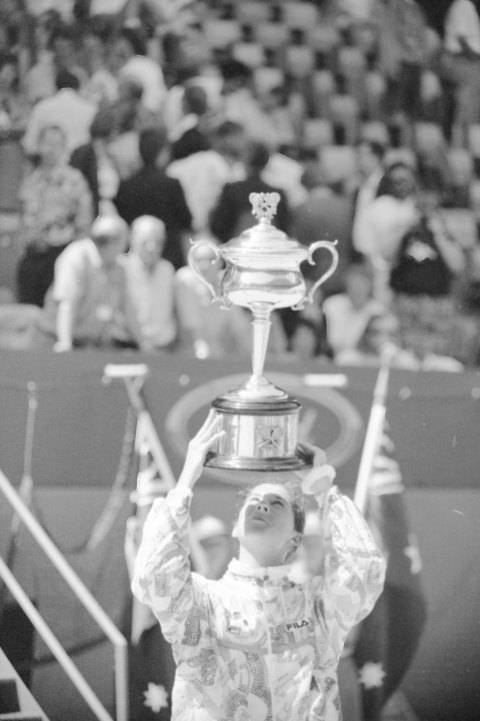
Monica Seles lifts the 1993 Australian Open Trophy.Credit: The Age
Monica Seles’s triumph over Steffi Graf in the 1993 final was arguably the greatest clash of their rivalry given its remarkable quality.
Graf, a winner of 22 major titles who was nicknamed “Fraulein Forehand” given her brilliance from that wing, was the dominant player on tour until the emergence of Seles.
In their fourth outing at grand slam level, the icons thumped winners from all corners of the court in a compelling final that extended the edge the double-handed Seles had over Graf.
She had previously edged the German to win the 1990 and 1992 Roland Garros finals before Graf bounced back to thrash her rival at Wimbledon.
Kooyong Classic tournament director Peter Johnston, who was working in a player liaison role for Tennis Australia at the time, practised regularly with Graf in the early 1990s.
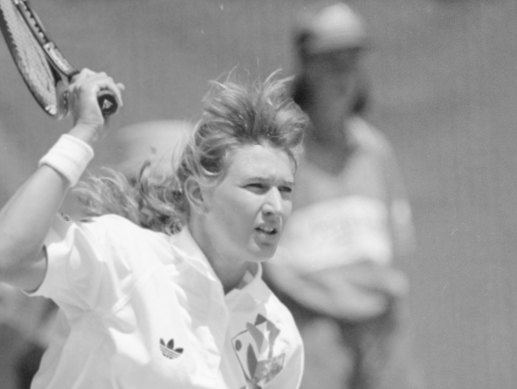
Steffi Graf, nicknamed Fraulein Forehand, during the final. Credit: The Age
Initially, he was sought out to help her prepare for matches against Martina Navratilova. But he also hit with her on occasion as Seles emerged as a shining star.
“She would arrive in Australia before Christmas and want to practise every day … and at that time of year not many people around, so I would get the call up,” he said.
The quality of that final stayed with him as Seles claimed her eighth grand slam title in less than three years.
“Both were at their absolute peak of their careers and it was a match in which they went toe to toe for a couple of hours,” Johnston said.
“It looked like becoming the best rivalry of all time in women’s tennis.”
Just a few months later, Seles was stabbed in the back while playing against Magdalena Maleeva in a tournament in Hamburg by a crazed fan of Graf.
She later completed one of sporting history’s great comebacks to win the 1996 Australian Open in what Paul McNamee described as “a super significant final”.
It was her last grand slam title. After the victory over Anke Huber, Seles received a question about returning to Germany, which devastated her.
“I got a message that Monica Seles was sobbing in the alleyway leading to Rod Laver Arena … after that media conference, because it opened up some wounds,” McNamee said.
“I took (my son) Rowan around and she was very upset, but when a little kid is there, you pick yourself up. It helped her get her composure back.”
1995 Andre Agassi (USA) d. Pete Sampras (USA) 4-6, 6-1, 7-6 (8), 6-4
It was a personal oasis that shielded one of the world’s most recognisable sportsmen from the hubbub following his every move.
And how Andre Agassi loved the privacy offered by the Albert Reserve Tennis Club.
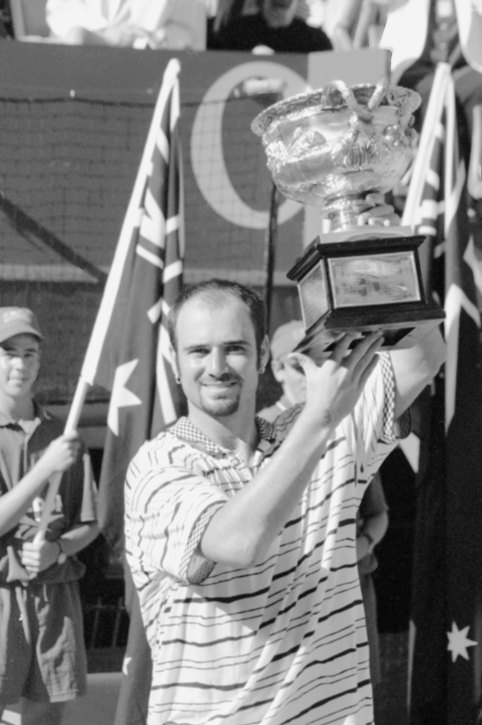
Andre Agassi with the winner’s trophy.Credit: The Age
The American had never been to Melbourne before 1995 but swiftly fell in love with a city where he claimed four of his eight major titles.
His coach Brad Gilbert said Agassi often stated that he wished he had visited Melbourne sooner given his love of the conditions.
“It was his first time coming to Australia and he had changed his look and cut his hair. He had this pirate look going on,” Gilbert said.
“And even though it was his first time, it was like ‘Wow’. The Australians really embraced him right off the bat.”
The reigning US Open champion was a rabble-rousing headline maker in his youth who had previously dated silver screen icon Barbra Streisand and was now seeing Brooke Shields.
He landed in Melbourne as the world’s No. 2 man and fired throughout a dramatic Australian Open memorable for the emotional distress of his great rival Sampras.
On the eve of the tournament Sampras’s coach Tom Gullickson had a seizure and was later diagnosed with inoperable brain cancer. It devastated the world No. 1.
In a remarkable quarter-final, Sampras broke down in tears in the fifth set against dual-champion Jim Courier, who offered to finish the match the next day.
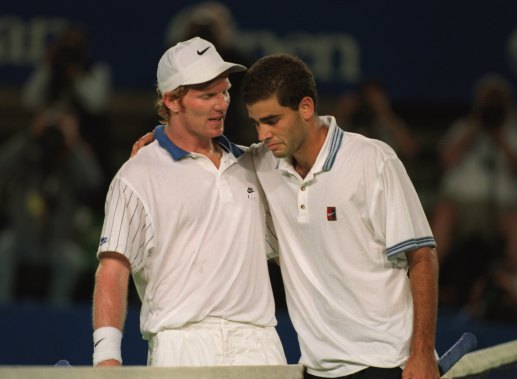
Sampras is comforted by his opponent Jim Courier after he broke down in tears during their quarter-final.Credit: Getty Images
Agassi, meanwhile, was playing “outrageously good tennis” and trounced players including future world No.1 Pat Rafter.
Part of the secret was preparing without hassle at Albert Park.
“It was like a little oasis for us. Sometimes, as a player, you get a routine or a superstition … and we had a good groove going there and we kept heading back there every day to train,” Gilbert said.
Gilbert did have concerns when Sampras clinched the first set. It was the only set Agassi dropped for the fortnight.
The third set tiebreaker proved critical. Agassi saved two set points, one a forehand return winner that clipped the net, before ending it with a backhand volley.
“It was an unbelievable nail biter. Everyone in the stadium knew how big that third set was,” Gilbert said.
2002 Jennifer Capriati (USA) d. Martina Hingis (SUI) 4-6, 7-6(7), 6-2
In one of the great Australian Open comebacks, Jennifer Capriati reeled in Martina Hingis to complete a successful title defence on a scorching day in Melbourne.
The second straight Australian Open final between the powerful American and the talented Swiss proved a highly dramatic affair with Hingis eventually wilting in extreme heat.
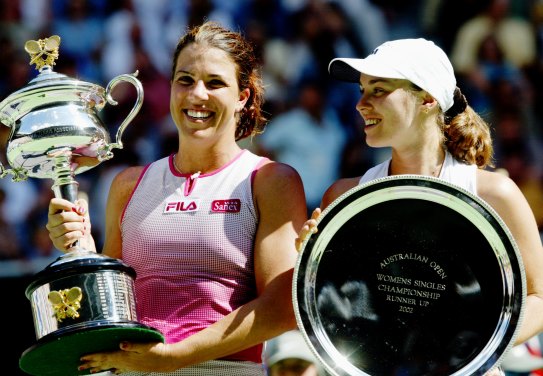
Jennifer Capriati conquered Martina Hingis in extreme heat.Credit: Vince Caligiuri
Capriati, the world No.1 whose star was at its peak after her troubles in the mid-1990s, found her best form in the second set to overcome a set and 0-4 deficit in searing conditions.
“I really don’t know how I managed to win today. I just kept fighting,” Capriati.
After a tense second set, with Hingis smashing her racquet after failing to convert four match points, it was clear that the three-time Australian Open champion was physically fried.
“I just wanted to have it behind me. I didn’t care at that point. You should always care but it was just impossible,” she said.
Paul McNamee, who coached Capriati for a period in her teens, is among those who marvelled at the bravery shown by Hingis.
“The trainers told me they had to pack Martina in ice packs during the break to try to get her temperature down and there was a doubt as to whether she would come back on the court,” McNamee said.
“We had an ambulance, a nurse and a doctor on standby in case she got worse. It was her choice to play, but there was serious doubt whether she would last that third set.”
It proved the last major final of their singles careers. Hingis retired for the first time just over a year later while Capriati’s reign ended as Serena Williams became the dominant woman.
2003: Serena Williams (USA) d. Venus Williams (USA) 7-6, 3-6, 6-4
When considering the grand career of Serena Williams, there is a strong case to state her triumph over Venus Williams in the 2003 Australian Open final is the most significant.
The sheer brilliance of the final, with the two American legends playing at the peak of their athletic powers, is a factor. The quality put to rest claims the sisters struggled to produce their best against each other, with the younger sibling eventually prevailing in a classic.
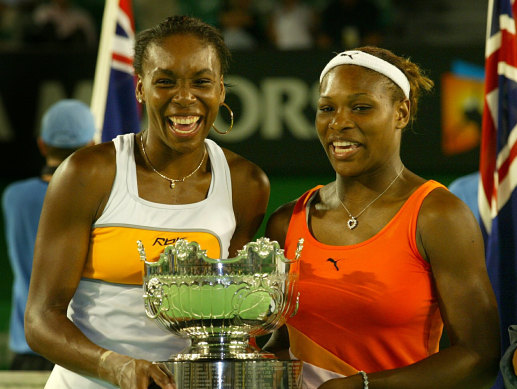
Sister act: Serena (right) defeated Venus in the 2003 Australian Open final.Credit: Ray Kennedy
Serena, who survived two match points to defeat Kim Clijsters in the semi-finals, showed just how much the triumph meant to her when breaking down during the trophy ceremony.
“I never get choked up. Never. But I’m really emotional right now and I’m really, really happy and I’d like to thank my mum and my dad for always supporting me,” she said.
There is a historical element to her triumph as well, with Williams completing the “Serena Slam” for the first time by claiming a maiden Australian Open title.
The grand slam, in which a player wins all four major titles in a calendar year, is the ultimate in tennis and the most recent player to manage the feat was Steffi Graf in 1988.
But Williams twice managed to hold all four grand slam titles at the same time, with the second occasion occurring between the 2014 US Open and Wimbledon in 2015.
All four of the grand slam triumphs that comprised the first “Serena Slam” came against her elder sister, but the Australian Open decider was by far the tightest of all four finals.
Craig Tiley coached the Fighting Illini at Illinois University to win the NCAA National Title in America that year and said the emergence of the Williams sisters had fuelled great optimism in the US.
“I met the Williams sisters when they were both quite young, along with their father Richard, and I had been to events where their entire family was, and had watched their rise in the game closely over many years,” he said.
“I remember watching her when she was younger and being amazed at how hard she hit the ball. She and Venus changed women’s tennis forever.”
Before the 2017 AO, he invited the sisters to talk when that year’s ball kids. A fortnight later, 14 years after that great final and in their late 30s, they squared off in another Australian Open final.
It served as the 23rd and final grand slam title claimed by Serena, who revealed a few weeks later that she was pregnant with her first child during the tournament.
It is also the last major final that Venus Williams has contested.
2005 Marat Safin (RUS) d. Lleyton Hewitt (AUS)
1-6, 6-3, 6-4, 6-4
Former Australian Open tournament director Paul McNamee argues Marat Safin’s triumph over Lleyton Hewitt is the most important final played at Melbourne Park.
The centenary Australian Open was memorable for several reasons, with the most significant move the decision to play the men’s final at night for the first time.
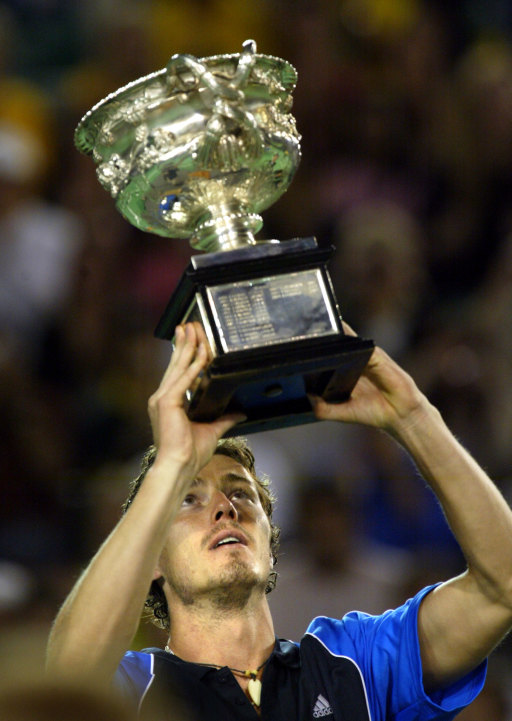
Marat Safin holds up the trophy.Credit: Angela Wylie
The tournament served as Melbourne’s farewell to Andre Agassi and welcome to Novak Djokovic, while Rafael Nadal reached the second week of a major for the first time.
It was also the last grand slam until the US Open in 2014 where a decider was played without at least one of Nadal, Federer or Djokovic as a participant.
But it was the final, with Jim Courier in the commentary box for the first time, which “galvanised the Australian Open as a prime-time entertainment product”, McNamee said.
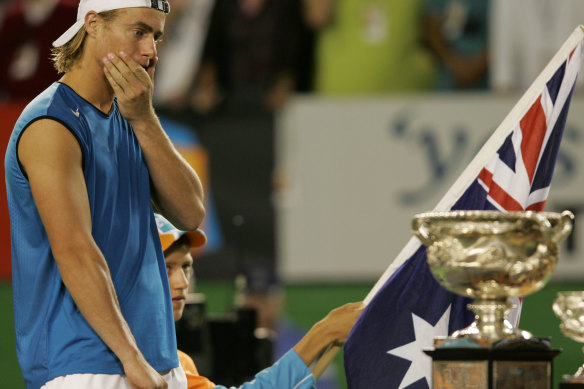
Lleyton Hewitt in defeatCredit: Vince Caligiuri
The Davis Cup star said he had a difficult job convincing television broadcasters to play the decider at night instead of as a lead-in to the evening news, but it proved a massive winner.
The broadcast averaged more than 4 million people across Australia and is still one of the most watched programs in the nation’s history.
“In my view, it is the most significant final played for those reasons. It really did change the game,” McNamee said.
“It blew the other channels out of the water in terms of the rating and it cemented the Australian Open, if it wasn’t already before, as Australia’s biggest sporting event.”
It all looked to be going so well for Hewitt when he delivered a near flawless opening set.
The dual-grand slam winner dropped just two points on serve in a swift first set lasting 23 minutes against Safin, who had survived a match point to oust Roger Federer in a semi-final.
A second set rally was not unexpected. Safin, who had reached two previous finals in Melbourne, was a prodigious talent when focused and capable of remarkable things.
Unfortunately for Hewitt, who appeared on track to win his home grand slam when leading 4-1 in the third set, his fellow former world No. 1 managed exactly that.
Safin’s level went from strong to superlative as he reeled off seven straight games to seize control and ultimately add the Australian crown to his US Open triumph in 2000.
“I’d like to congratulate Marat on a hell of a tournament. You knocked off the guy (Federer) who’s been virtually impossible to beat, so you definitely deserve it,” Hewitt said.
2012 Novak Djokovic (SRB) d. Rafael Nadal (SPA)
5-7, 6-4, 6-2, 6-7 (5), 7-5
When considering the finest matches of all-time, Novak Djokovic’s 2012 triumph over Rafael Nadal at Melbourne Park in a record-breaking decider rates highly.
There is the duration; at five hours and 33 minutes, it lasted just shy of one hour longer than the previous record for a major final and the last trains were long gone from Flinders St Station when the champions embraced at the net at 1.37am.
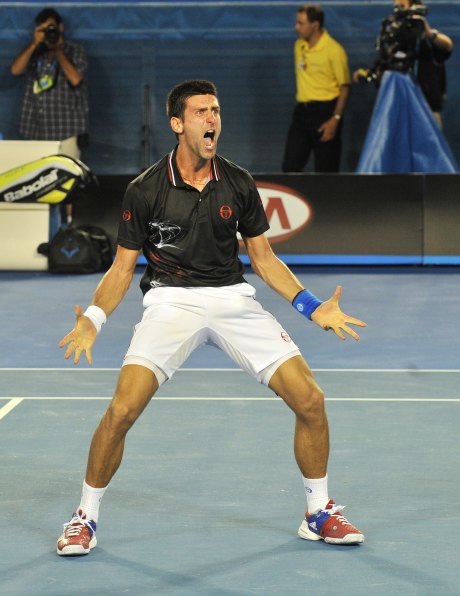
Djokovic roars after winning a marathon final. Credit: Joe Armao
The quality of tennis added another dimension. Nadal called it his toughest loss but also the finest match he had played. Djokovic said it was the best win of his career.
The standard was as impeccable as their endurance proved astonishing. It is the only time Nadal has lost a grand slam final after claiming the first set. But he fought brilliantly.
Djokovic looked to have all the answers when he broke twice to claim the third set. The Spaniard found a way with his back against the wall in the fourth.
The two legends went toe-to-toe in an enthralling last set. Newspaper editors held final editions. Fans were glued to couches. The stands remained full.
“It was obvious on the court for everybody who has watched the match that both of us, physically, took the last drop of energy that we had from our bodies,” Djokovic said.
“We made history tonight and unfortunately there couldn’t be two winners.”
Brad Gilbert, who was providing special analysis for ESPN, remembers the Serbian being understandably exhausted when he finally arrived for a post-match interview close to 3am.
“I almost felt, sitting there courtside, that they had taken tennis to a different stratosphere that night,” Gilbert said.
“The sheer ability of both of them, to throw themselves around the court for that long, you almost had to pinch yourself to believe what you were seeing.”
Read Greg Baum’s report from the final here.
2017 Roger Federer (SUI) d. Rafael Nadal (SPA)
6-4, 3-6, 6-1, 3-6, 6-3
For all the magnificence of their rivalry, the prospect of Roger Federer meeting Rafael Nadal in the 2017 Australian Open final seemed absurd given their recent history.
Federer had not won a major title since Wimbledon in 2012. Nadal’s drought dated back to a success at Roland Garros in 2014. And both men were well into their 30s.

Roger Federer in full flight.Credit: Alex Ellinghausen
The Swiss had undergone knee surgery and had not played an official tournament since Wimbledon. Nadal played only sporadically through 2016 due to a lingering wrist problem.
But the old adage rang true. Never write off a champion. When Novak Djokovic was upset early in the tournament, all eyes at Melbourne Park turned to his greatest rivals.
They delivered in spades, dispatching top-line rivals throughout the fortnight before producing a compelling decider.
“I don’t think either of us thought we would be in the final,” he said. “But the comeback was as perfect as (possible).”
Nadal brought Federer to tears when too strong for him in the 2009 Australian Open final. With a 3-1 lead in the fifth set, another triumph seemed in store for the Spaniard.
But Federer struck gold with the boldest of play, blasting an improved backhand to reel off the last five games.
Pat Cash, who was providing analysis for the final for the BBC, recalls Federer hitting his backhand better than ever before in what is arguably his greatest ever win.
“I kept thinking to myself, watching that match, he is going to make a mistake. But instead he hit a couple of unbelievable backhands,” Cash said.
“I remember thinking, ‘Oh My God’. That was a new tactic Roger had been working on.”
Cash said the “drama of the match exceeded the Djokovic and Nadal (2012) final because the crowd were going absolutely nuts”.
It was Federer’s first win over Nadal in a grand slam final since a triumph at Wimbledon in 2007 and changed the momentum of their rivalry, with the Swiss winning seven of their last eight matches to close their head-to-head to 24-16 in the Spaniard’s favour.
And it was well-received. It was EuroSport’s most-watched tennis match of all time and second highest-rating sports telecast, set a record for ESPN for night-time finals and was the most watched match in Australia since Lleyton Hewitt played Marat Safin in the 2005 decider.
Read Greg Baum’s report from the final here.
2018 Caroline Wozniacki (DEN) d. Simona Halep (ROM)
7-6 (2), 3-6, 6-4
By edging Simona Halep in a gripping Australian Open final, Caroline Wozniacki became the first Danish player to win a grand slam title while also shedding a most unwanted tag.
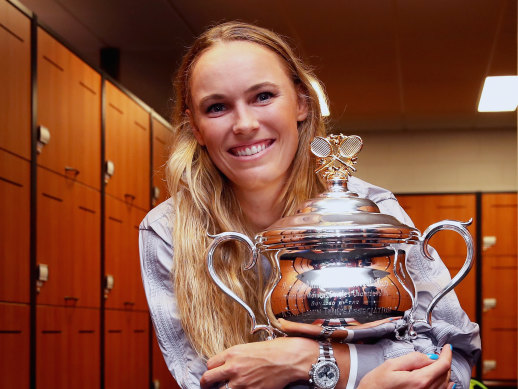
Caroline Woziacki shed the “best player never to win a major” tag.Credit: Getty Images
Seven years after claiming the world’s top ranking for the first time, the outstanding baseliner put an end to questions about whether she would ever become a major champion.
“I dreamed of this moment for so many years. To be here today is a dream come true. I never cry, but today is an emotional moment,” Wozniacki said.
Wozniacki delivered in style in a marvellous final where the precise shotmaking and exceptional movement from both women made for a compelling contest.
The match point encapsulated the entire final, with the Dane defending from the outer reaches of the court to eventually draw an error from her fatiguing rival.
Wozniacki benefited from a compulsory break between the second and third sets in place due to extreme heat on what was a stifling night in Melbourne.
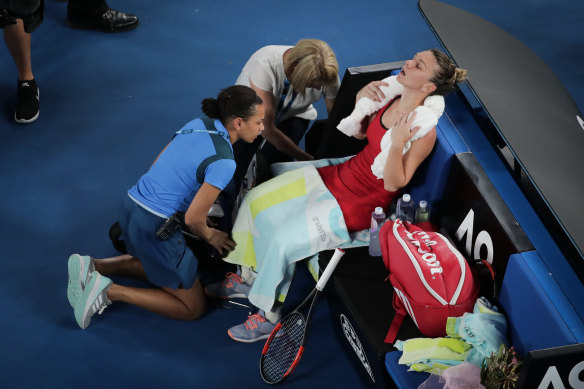
Simona Halep receives medical treatment during her final against Caroline Wozniacki.Credit: Alex Ellinghausen
Halep, who reached the final despite injuring an ankle early in the tournament, was later hospitalised for treatment related to heaT stress.
Wozniacki, who had lost her two previous grand slam finals to Kim Clijsters and Serena Williams, had dropped to 74 in the rankings a year earlier but was able to regain her best.
Early in the tournament, Wozniacki overcame a 1-5 deficit and two match points in the deciding set to defeat Jana Fett. But from there she found her championship qualities.
“At certain points, when you have injuries, you start doubting if you’re ever going to be 100 percent healthy for long periods of time … but I’ve proved I can beat anyone on court,” Wozniacki said.
Australian Open tournament director Craig Tiley said the drama surrounding Wozniacki’s status as among the best players never to win a slam added to the importance of the final.
“The tension was palpable but the pace at which they hit the ball was remarkable,” Tiley said.
“Simona was at the height of her career and playing great tennis, and Caroline took her game to the next level, and was able to pull off arguably the best match of her career, which we were all fortunate to witness.”
Read Scott Spits’ report from the final here
2022 Ash Barty (AUS) d. Danielle Collins (USA)
6-3, 7-6 (2)
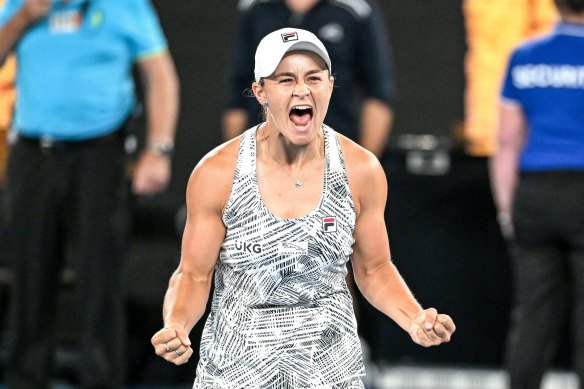
Ash Barty breaks a 44-year drought.Credit: Eddie Jim
Shortly before last year’s Australian Open final, Ash Barty was bouncing on her feet while chatting with her coach Craig Tyzzer.
The Queenslander appeared relaxed ahead of her bid to end a title drought by locals that had stretched to 44 years. But the calm exterior belied her true emotions.
As she walked along the corridor to Rod Laver Arena, past the photographs denoting previous champions, Barty’s heart was pounding.
“I could hear the rumbling and the murmuring as I came down that tunnel and it was loud. I could sense the crowd’s excitement,” she told The Age and the Herald.
“I was excited myself. I had that dry mouth and my heart was beating that little bit faster.”
The next 90 minutes provided the perfect punctuation point for a glittering career.
It is not the best final played at Melbourne Park but, from an Australian perspective, it is the most important. The drought was over.
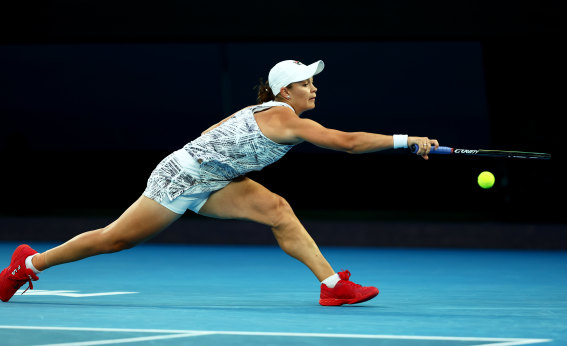
Ash Barty en route to winning the Australian Open.Credit: Getty Images
The 2021 Wimbledon champion started brilliantly, using her serve and variety to unsettle Collins. But to the American’s credit, she rallied strongly.
An aggressive baseliner, Collins blazed the line with blistering forehands and backhands in the second set to move to a 5-1 lead.
Barty began punching her thighs. Move, she urged herself. And she did by stepping forward to clip a couple of returns.
It was an important adjustment that caught Collins out and the momentum changed again.
The composure the top seed displayed to overcome that deficit and the class she showed when crushing a forehand winner across court to win the title was immense.
It was the last forehand she would hit in a grand slam match. And it was a ripper.
Barty doubled over and unleashed a guttural roar of triumph.
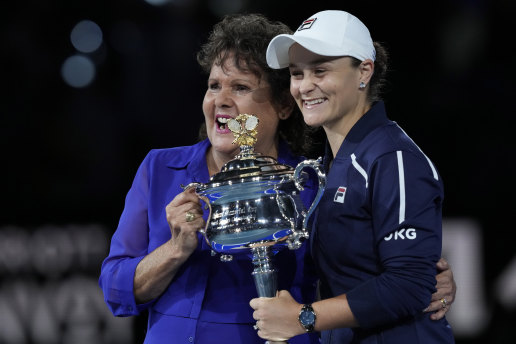
Evonne Goolagong Cawley presents the Daphne Akhurst Memorial Cup to Ash Barty after last year’s Australian Open women’s final.Credit: AP
The ceremony was a blur. But celebrations with her family and friends including Evonne Goolagong Cawley and Cathy Freeman are treasured memories.
After completing media commitments, she headed to an after party in the city but managed just one beer before exhaustion set in.
“Waking up the next morning, when it all started to sink in, that is when it started to feel a bit strange,” she said.
“What had felt like a dream for me to live out had happened and I felt really fortunate. It was a brilliant way to finish.”
Read Greg Baum’s report from the final here.
For daily updates of all the tennis action during the Australian Open, sign up for our Sport newsletter here.